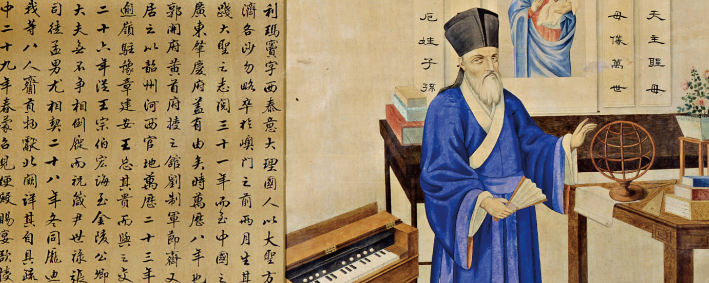 |
CCCH9004 China: Culture, State and SocietyIdeas and Images of the West in Late Imperial ChinaThis course is under the thematic cluster(s) of:
|
Course Description
During the late imperial period (17th-19th centuries), China was involved in substantive exchanges with the West in politics, religion, sciences, and arts. They made great impacts on China’s later development towards a modern nation. How did the Chinese people perceive and conceptualize the West in textual and visual representations? What factors may have contributed to the creation of diverse ideas and images of the West, including “red-haired barbarians”, “Holy Mother”, “scholars from the West”, “heavenly brothers”, and “foreign masters”, etc.? Are there any common characteristics among these ideas and images, and in what ways did they affect China’s transition from tradition to modernity? For some special terms like the “foreign devil” (Yang guizi 洋鬼子 in Mandarin, or Gweilo 鬼佬 in Cantonese), why do Chinese continue to use them today to refer to the Westerners? In this course, students will have an opportunity to search for answers to these questions through a set of exemplary case studies. They will explore both textual and visual sources to analyze the formation and transformation of a certain idea or image of the West, as well as its historical and cultural implications. Important theories in history, comparative literature and cultural studies will be introduced to facilitate in-depth discussions and critical reflections. From an interdisciplinary perspective, students will be able to reflect upon the increasing presence of the West in late imperial China, explore the changing Chinese identities mirrored by the Western other(s), and express their opinions on controversial issues such as the meaning of Chineseness and the compatibility between Chinese and Western cultures.

Course Learning Outcomes
On completing the course, students will be able to:
- Demonstrate knowledge of the traditional Sino-centric world order and its continuous impacts on late imperial Chinese society.
- Critically evaluate varied types of textual and visual sources, and develop ability to summarize differences and similarities among the ideas/images extracted from these sources.
- Reflect on important historical and social factors that conditioned Chinese perception, representation, and imagination of the West.
- Apply a comprehensive approach and critical analysis to a wide range of academic discussions and writings.
- Demonstrate understanding of diversity and dynamism of Chinese culture from past to present, and reconsider Chinese ethnic/cultural identity in a multi-cultural context.
Offer Semester and Day of Teaching
Second semester (Wed)
Study Load
| Activities | Number of hours |
| Lectures | 24 |
| Tutorials | 8 |
| Reading / Self-study | 35 |
| Assessment: Essay / Report writing | 30 |
| Assessment: Discussion, debate, presentation (incl preparation) | 30 |
| Total: | 127 |
Assessment: 100% coursework
| Assessment Tasks | Weighting |
| Class participation | 10 |
| Tutorial participation | 40 |
| Term paper | 50 |
Required Reading
- Clarke, J. (2013). The Virgin Mary and Catholic Identities in Chinese History. Hong Kong: Hong Kong University Press. [pp. 24-37]
- Cohen, P. A. (1974). Between tradition and modernity: Wang T’ao and reform in late Ch’ing China. Cambridge, MA: Harvard University Press. [pp. 209-235]
- Fairbank, J. K. (Ed.). (1968). The Chinese world order: Traditional China’s foreign relations. Cambridge, MA: Harvard University Press. [pp. 1-13]
- Franke, W. (1967). China and the West (R. A. Wilson, Trans.). Oxford: Basil Blackwell. [pp. 66-91]
- Hsia, R. P. -C. (2008). The Question of Who? Chinese in Europe. In K. K. Chatterjee & C. Hawkes (Eds.), Europe Observed: The Reversed Gaze in Early Modern Encounters (pp. 83-101). Lewisburg: Bucknell University Press.
- Gernet, J. (1985). China and the Christian impact: A conflict of cultures. Cambridge: Cambridge University Press. [pp. 112-126]
- Meng, H. (2000). The Chinese genesis of the term “Foreign Devil”. In H. Meng & S. Hirakawa (Eds.), Images of Westerners in Chinese and Japanese literature, (pp. 25-37). Amsterdam: Rodopi.
- Michael, F. H. (1971). The Taiping Rebellion: History and documents. Seattle: University of Washington Press. [pp. 715-721]
- Mish, J. L. (1964). Creating an image of Europe for China: Aleni’s Hsi-fang ta-wen. Monumenta Serica: Journal of Oriental Studies, 23, 43-63.
- Smith, R. J. (2013). Mapping China and managing the world: Culture, cartography, and cosmology in late imperial times. New York: Routledge. [pp. 52-75]
- Ye, X. (2003). The Dianshizhai pictorial: Shanghai urban life, 1884-1898. Ann Arbor, MI: Center for Chinese Studies, The University of Michigan. [pp. 117-131]
Course Co-ordinator and Teacher(s)
| Course Co-ordinator | Contact |
| Professor G. Song School of Chinese, Faculty of Arts |
Tel: 3917 7921 Email: songg@hku.hk |
| Teacher(s) | Contact |
| Professor G. Song School of Chinese, Faculty of Arts |
Tel: 3917 7921 Email: songg@hku.hk |

